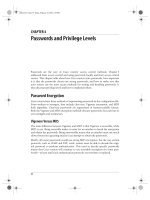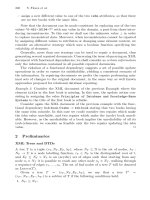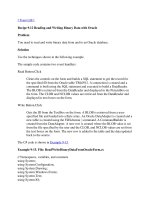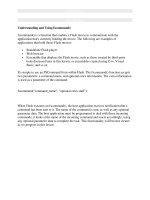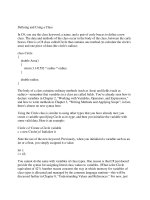Tài liệu Passwords and Privilege Levels pdf
Bạn đang xem bản rút gọn của tài liệu. Xem và tải ngay bản đầy đủ của tài liệu tại đây (137.57 KB, 11 trang )
This is the Title of the Book, eMatter Edition
Copyright © 2002 O’Reilly & Associates, Inc. All rights reserved.
32
Chapter 4
CHAPTER 4
Passwords and Privilege Levels
Passwords are the core of Cisco routers’ access control methods. Chapter 3
addressed basic access control and using passwords locally and from access control
servers. This chapter talks about how Cisco routers store passwords, how important
it is that the passwords chosen are strong passwords, and how to make sure that
your routers use the most secure methods for storing and handling passwords. It
then discusses privilege levels and how to implement them.
Password Encryption
Cisco routers have three methods of representing passwords in the configuration file.
From weakest to strongest, they include clear text, Vigenere encryption, and MD5
hash algorithm. Clear-text passwords are represented in human-readable format.
Both the Vigenere and MD5 encryption methods obscure passwords, but each has its
own strengths and weaknesses.
Vigenere Versus MD5
The main difference between Vigenere and MD5 is that Vigenere is reversible, while
MD5 is not. Being reversible makes it easier for an attacker to break the encryption
and obtain the passwords. Being unreversible means that an attacker must use much
slower brute force guessing attacks in an attempt to obtain the passwords.
Ideally, all router passwords would use strong MD5 encryption, but the way certain
protocols, such as CHAP and PAP, work, routers must be able to decode the origi-
nal password to perform authentication. This need to decode specific passwords
means that Cisco routers will continue to use reversible encryption for some pass-
words—at least until such authentication protocols are rewritten or replaced.
,ch04.23611 Page 32 Friday, February 15, 2002 2:53 PM
This is the Title of the Book, eMatter Edition
Copyright © 2002 O’Reilly & Associates, Inc. All rights reserved.
service password-encryption
|
33
Clear-Text Passwords
Chapter 3 sets passwords using line passwords, local username passwords, and the
enable secret command. A show run provides the following:
enable secret 5 $1$Guks$Ct2/uAcSKHkcxNKyavE1i1
enable password enable-password
!
username jdoe password 0 jdoe-password
username rsmith password 0 rsmith-password
!
line con 0
exec-timeout 5 0
password console-password
login local
transport input none
line aux 0
exec-timeout 5 0
password aux-password
login tacacs
transport input none
line vty 0 4
exec-timeout 5 0
password vty-password
login
transport input ssh
The highlighted parts of the configuration are the passwords. Notice that all pass-
words, except the enable secret password, are in clear text. This clear text poses a sig-
nificant security risk. Anyone who can view a copy of the configuration file—
whether through shoulder surfing or off a backup server—can see the router pass-
words. We need a way to make sure that all passwords in the router configuration
file are encrypted.
service password-encryption
The first method of encryption that Cisco provides is through the command service
password-encryption. This command obscures all clear-text passwords in the configura-
tion using a Vigenere cipher. You enable this feature from global configuration mode.
Router#config terminal
Enter configuration commands, one per line. End with CNTL/Z.
Router(config)#service password-encryption
Router(config)#^Z
Now a show run command no longer displays the password in humanly readable for-
mat.
enable secret 5 $1$Guks$Ct2/uAcSKHkcxNKyavE1i1
enable password 7 02030A5A46160E325F59060B01
,ch04.23611 Page 33 Friday, February 15, 2002 2:53 PM
This is the Title of the Book, eMatter Edition
Copyright © 2002 O’Reilly & Associates, Inc. All rights reserved.
34
|
Chapter 4: Passwords and Privilege Levels
!
username jdoe password 7 09464A061C480713181F13253920
username rsmith password 7 095E5D0410111F5F1B0D17393C2B3A37
!
line con 0
exec-timeout 5 0
password 7 110A160B041D0709493A2A373B243A3017
login local
transport input none
line aux 0
exec-timeout 5 0
password 7 0005061E494B0A151C36435C0D
login tacacs
transport input all
line vty 0 4
exec-timeout 5 0
password 7 095A5A1054151601181B0B382F
login
transport input ssh
The only password not affected by the service password-encryption command is the
enable secret password. It always uses the MD5 encryption scheme.
While the service password-encryption command is beneficial and should be enabled
on all routers, remember that the command uses an easily reversible cipher. Some
commercial programs and freely available Perl scripts instantly decode any pass-
words encrypted with this cipher. This means that the service password-encryption
command protects only against casual viewers—someone looking over your shoul-
der—and not against someone who obtains a copy of the configuration file and runs
a decoder against the encrypted passwords. Finally, service password-encryption does
not protect all secret values such as SNMP community strings and RADIUS or
TACACS keys.
Enable Security
The enable, or privileged, password has an additional level of encryption that should
always be used. The privileged-level password should always use the MD5 encryp-
tion scheme.
In early IOS configurations, the privileged password was set with the enable
password command and was represented in the configuration file in clear text:
enable password ena-password
For additional security, Cisco added the service password-encryption command to
obscure all clear-text passwords:
service password-encryption
enable password 7 02030A5A46160E325F59060B01
,ch04.23611 Page 34 Friday, February 15, 2002 2:53 PM
This is the Title of the Book, eMatter Edition
Copyright © 2002 O’Reilly & Associates, Inc. All rights reserved.
Strong Passwords
|
35
However, as explained earlier, this uses the weak Vigenere cipher. Because of the
importance of the privileged-level password and the fact that it doesn’t need to be
reversible, Cisco added the enable secret command that uses strong MD5 encryption:
Router#config terminal
Enter configuration commands, one per line. End with CNTL/Z.
Router(config)#enable secret my-secret-password
Router(config)#^Z
A show run now displays:
enable secret 5 $1$Guks$Ct2/uAcSKHkcxNKyavE1i1e
This type of encryption cannot be reversed. The only way to attack it is though brute
force methods.
You should always use the enable secret command instead of enable password. The
enable password command is provided only for backward compatibility. If both are
set, for example:
enable password 7 02030A5A46160E325F59060B01
enable secret 5 $1$Guks$Ct2/uAcSKHkcxNKyavE1i1e
the enable secret password takes precedence and the enable password command is
ignored.
Many organizations begin using the insecure enable password com-
mand, and then migrate to using the enable secret command. Often,
however, they use the same passwords for both the enable password
and enable secret commands. Using the same passwords defeats the
purpose of the stronger encryption provided by the enable secret com-
mand. Attackers can simply decode the weak encryption from the
enable password command to get the router’s password. To avoid this
weakness, be sure to use different passwords for each command—or
better yet, don’t use the enable password command at all.
Strong Passwords
In addition to using encryption to keep passwords from appearing in human-read-
able form, secure password protection requires the use of strong passwords. There
are two requirements for strong passwords. First, they are difficult to guess or crack.
Second, they are easy to remember. If the password is based on a word found in a
dictionary—a name, a place, and so on—the password is weak. If the password is a
complete random string of letters and numbers, the password is strong, but users
end up writing the password down because they can’t remember it. To demonstrate
how easy it is to crack weak passwords, the following passwords were encrypted
with the strong MD5 encryption:
• hello
• Enter0
,ch04.23611 Page 35 Friday, February 15, 2002 2:53 PM
This is the Title of the Book, eMatter Edition
Copyright © 2002 O’Reilly & Associates, Inc. All rights reserved.
36
|
Chapter 4: Passwords and Privilege Levels
• 9spot
• 8twelve8
• ilcic4l
A brute force password-cracking program was used to see how long it would take to
guess each password.
On a Sun Ultra 5 with 512MB of RAM and a 333MHz processor, the first password,
hello, took less than five seconds to crack. This is the same amount of time it would
take to guess most words in the English language (or a word in any other language, if
the attacker included foreign language dictionaries). After four hours, the password
cracker has guessed the next three passwords as well. Any password based on a
word—English or foreign—is vulnerable to brute force attacks.
The last password looks random and was still not cracked when the password cracker
stopped running three days later. The problem is remembering a password like this
one. See the upcoming sidebar, “Choosing and Remembering Strong Passwords” for
tips on choosing an appropriate password.
Keeping Configuration Files Secure
Except for the enable secret password, all passwords stored on Cisco routers are
weakly encrypted. If someone were to get a copy of a router configuration file, it
would take only a few seconds to run it through a program to decode all weakly
encrypted passwords. The first protection is to keep the configuration files secured.
You should always have a backup of each router’s configuration file. You should prob-
ably have multiple backups. However, each of these backups must be kept in a secure
location. This means that they are not stored on a public server or on each network
administrator’s desktop. Additionally, backups of all routers are usually kept on the
same system. If this system is insecure, and an attacker can gain access, he has hit the
jackpot—the complete configuration of your entire network, all access list setups,
weak passwords, SNMP community strings, and so on. To avoid this problem, wher-
ever backup configuration files are kept, it is best to keep them encrypted. That way,
even if an attacker gains access to the backup files, they are useless.
Encryption on an insecure system, however, provides a false sense of security. If
attackers can break into the insecure system, they can set up a key logger and cap-
ture everything that is typed on that system. This includes the passwords to decrypt
the configuration files. In this case, an attacker just has to wait until the administra-
tor types in the password, and your encryption is compromised.
Another option is to make sure your backup configuration files don’t contain any
passwords. This requires that you remove the password from your backup configura-
tions manually or create scripts that strip out this information automatically.
,ch04.23611 Page 36 Friday, February 15, 2002 2:53 PM

